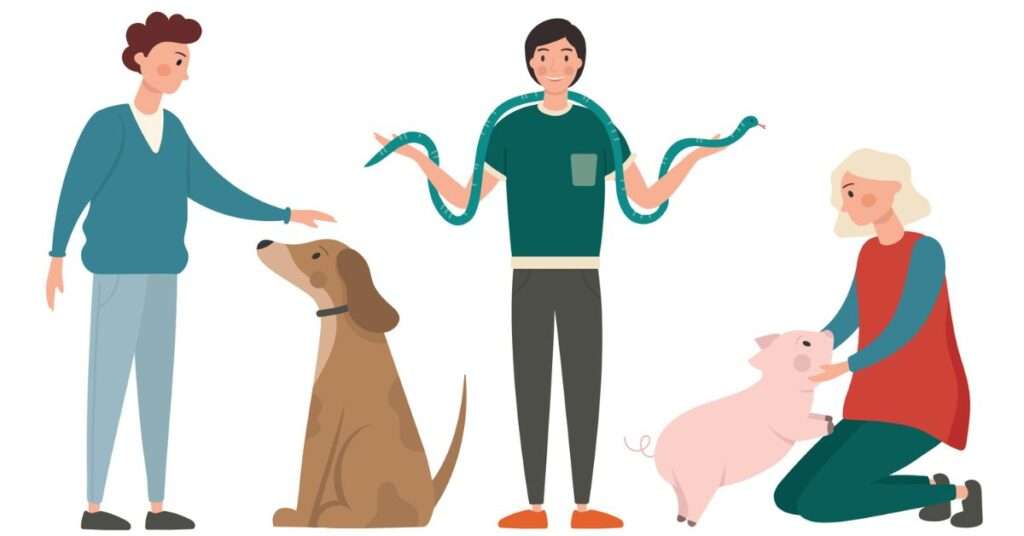Understanding pet behavior and body language is crucial for pet owners to build a strong bond with their furry companions. Pets, whether they are dogs or cats, communicate with their owners through various body language signals and vocalizations.
Also Read
By understanding these cues, pet owners can ensure their pets’ well-being and provide them with the care they need.
Body language is a crucial aspect of pet behavior that pet owners need to understand. For example, a dog wagging its tail can mean different things depending on the context. A wagging tail can indicate excitement, happiness, or even aggression.
Similarly, a cat’s body language can communicate its mood, such as when it arches its back or flattens its ears. Understanding these cues can help pet owners respond appropriately to their pets’ needs.
Moreover, pets communicate with their owners through vocalizations such as barks, meows, and purrs. These sounds can convey different emotions, such as happiness, fear, or anxiety.
By interpreting these vocalizations, pet owners can provide their pets with the care and attention they need. Understanding pet behavior and body language is an essential part of being a responsible and caring pet owner.
The Basics of Pet Behavior
Understanding your pet’s behavior is crucial to building a strong bond with them. It can also help you identify any potential health issues or concerns. Here are some basic behaviors to look out for:
Body Language
Pets communicate through body language, and it’s important to understand what they’re trying to say. Some common body language cues in pets include:
- Tail wagging: A dog wagging its tail can indicate excitement, happiness, or even aggression. It’s important to look at the rest of the body language to understand the context.
- Ears: The position of a pet’s ears can indicate their mood. For example, a dog with its ears pinned back may be scared or submissive, while a cat with its ears forward may be alert or curious.
- Posture: The way a pet holds its body can also indicate its mood. A relaxed pet may have loose muscles and a slightly curved spine, while a scared pet may have a stiff body and raised fur.
Vocalizations
Pets also communicate through vocalizations, such as barking, meowing, or purring. Here are some common vocalizations and what they may mean:
- Barking: Dogs may bark to alert their owners, express excitement, or communicate fear or aggression.
- Meowing: Cats may meow to get attention, express hunger, or communicate discomfort or distress.
- Purring: Cats may purr when they’re happy, relaxed, or seeking attention.
Aggression
While most pets are friendly and loving, they may exhibit aggressive behavior in certain situations. Signs of aggression may include:
- Growling or hissing
- Biting or scratching
- Stiff body posture
- Raised fur
- Dilated pupils
It’s important to identify the cause of aggression and work with a veterinarian or animal behaviorist to address the issue.
Understanding your pet’s behavior can help you build a stronger bond with them and ensure their overall health and well-being.
By paying attention to their body language, vocalizations, and behavior, you can better understand their needs and communicate with them effectively.

Understanding Body Language in Dogs
Dogs communicate their emotions and intentions through body language. Understanding their body language is crucial to ensuring a happy and healthy relationship between dogs and their owners. Here are some essential body language cues to look out for:
Tail Wagging
Tail wagging is one of the most common and recognizable body language cues in dogs. However, it’s essential to note that not all tail wagging is a sign of happiness. A dog’s tail position, speed, and direction of the wag can convey different emotions.
A high and stiff tail wag indicates alertness or aggression, while a low and relaxed tail wag indicates calmness and friendliness.
Ear Positioning
Dogs use their ears to communicate their emotions. When a dog’s ears are relaxed and in a natural position, it indicates that they are calm and content.
However, when a dog’s ears are pulled back, it indicates fear or submission. On the other hand, when a dog’s ears are perked up, it indicates alertness or excitement.
Barking and Vocalization
Dogs use barking and other vocalizations to communicate their emotions. A low growl can indicate aggression or fear, while a high-pitched whine can indicate excitement or anxiety.
It’s essential to pay attention to the context and other body language cues to understand the dog’s emotions accurately.
Understanding a dog’s body language is crucial to ensure a healthy and happy relationship between dogs and their owners.
By paying attention to tail wagging, ear positioning, and vocalization, owners can better understand their dog’s emotions and respond appropriately to their needs.
Understanding Body Language in Cats
Cats have their own unique way of communicating with their owners. Understanding their body language is important to providing the best care for them. Here are some common body language signals that cats use:
Purring
Cats purr when they are content and happy. However, they can also purr when they are in pain or feeling stressed. It is important to pay attention to other body language signals to determine the reason for their purring.
Kneading
Kneading is when a cat pushes their paws in and out on a soft surface. This behavior is a sign of contentment and relaxation. It is a behavior that is typically seen in kittens when they are nursing from their mother.
Tail Flicking
A cat’s tail is a good indicator of their mood. If a cat’s tail is twitching or flicking, it can be a sign that they are agitated or annoyed. If their tail is puffed up, it can be a sign that they are scared or feeling threatened. A relaxed tail that is held high is a sign of a happy and confident cat.
Understanding these common body language signals can help cat owners provide the best care for their furry friends.
Interpreting Bird Body Language
Understanding bird body language is crucial for pet owners to have a good relationship with their feathered friends. Birds use their body language to communicate a range of emotions and needs. Here are some common bird body language signs and what they mean.
Feather Fluffing
Feather fluffing is a common behavior in birds. It can indicate that the bird is relaxed and comfortable or that it is feeling cold. However, if the bird is fluffing its feathers excessively, it could indicate that it is stressed or sick. In this case, it is important to observe other signs of behavior and consult a veterinarian if necessary.
Beak Grinding
Beak grinding is a sign that a bird is relaxed and content. It is a common sound of a happy bird that is comfortable in its environment. However, beak grinding can also indicate pain or discomfort in some situations. It is important to observe other body language signs to determine the reason for the beak grinding.
Wing Flapping
Wing flapping can mean many different things such as being angry or in pain. Flapping can also be used to fluff the feathers or get the feathers to lay just right. Wing flapping accompanied by hunching of the shoulders and head bobbing is attention-getting and often means that a bird wants to be fed.
Observing and interpreting bird body language can help pet owners understand their bird’s needs and emotions. It is important to pay attention to other body language signs and consult a veterinarian if necessary.
By understanding bird body language, pet owners can provide a comfortable and happy environment for their feathered friends.

Understanding Small Mammal Behavior
Small mammals, such as hamsters, guinea pigs, and rabbits, make great pets for many people. However, it is important to understand their behavior to ensure they are happy and healthy.
Here are some common behaviors you may observe in small mammals and what they mean.
Gnawing
Small mammals have a natural instinct to gnaw on things. This behavior helps keep their teeth healthy and worn down to an appropriate length.
However, excessive gnawing may indicate boredom or stress. Providing chew toys or hiding food in puzzle toys can help keep them mentally stimulated and reduce the likelihood of destructive gnawing.
Squeaking
Squeaking is a common vocalization for many small mammals. Guinea pigs, for example, may squeak when they are excited or happy.
However, frequent or prolonged squeaking may indicate discomfort or pain. If you notice excessive squeaking, it is important to monitor your pet closely and consult with a veterinarian if necessary.
Biting
While biting is not a desirable behavior in any pet, it is important to understand why a small mammal may bite. Fear or discomfort may cause a small mammal to bite as a defensive mechanism.
Additionally, some small mammals may bite if they are not handled properly or if they feel threatened. It is important to be gentle and patient when handling small mammals to avoid biting incidents.
In summary, small mammals have unique behaviors that are important to understand to ensure their well-being. Providing appropriate toys, monitoring vocalizations, and handling them gently can help reduce stress and promote a happy and healthy pet.
Reading Reptile Body Language
Reptiles are fascinating creatures that communicate in their own unique way. Understanding their body language is crucial for pet owners to ensure that their reptile is healthy and happy. In this section, we will discuss some of the common body language signals exhibited by reptiles.
Color Changes
One of the most obvious ways reptiles communicate is through changes in their skin color. Bearded dragons, for example, can change their color to indicate their mood. When they are happy and relaxed, their skin is light in color. When they are stressed or threatened, their skin turns darker.
Chameleons are another example of reptiles that change color to communicate. Their ability to change color helps them blend into their surroundings and avoid predators.
Hissing
Hissing is a common body language signal exhibited by many reptiles, including snakes and bearded dragons. When a reptile hisses, it is a sign of aggression or fear.
It is a warning to potential predators or threats to stay away. If a pet reptile is hissing, it is best to give it some space and try to identify the source of its discomfort.
Shedding
Shedding is a natural process for many reptiles, including snakes, lizards, and turtles. It is a sign that they are growing and developing.
During shedding, reptiles may exhibit changes in behavior, such as decreased appetite or increased lethargy. It is important to monitor a pet reptile during shedding to ensure that they are healthy and comfortable.
In summary, reptiles communicate through a variety of body language signals, including color changes, hissing, and shedding. Understanding these signals is essential for pet owners to ensure that their reptile is healthy and happy.
Understanding Fish Behavior
Fish are fascinating creatures with their own unique behaviors and body language. As a pet owner, it’s important to understand how to interpret their behavior to ensure their health and well-being.
In this section, we will delve into the intricacies of fish behavior, helping you decode their actions and gain valuable insights into their well-being.
Swimming Patterns
Fish swimming patterns can reveal a lot about their behavior. For example, if a fish is swimming erratically or frantically, it may be a sign of stress or discomfort. On the other hand, if a fish is swimming smoothly and gracefully, it’s likely a sign of good health.
Different species of fish also have their own unique swimming patterns. For example, some species of fish are known for their darting movements, while others are more sluggish and slow-moving. By observing your fish’s swimming patterns, you can gain a better understanding of their behavior and overall health.
Color Changes
Fish can also communicate through changes in their coloration. For example, a fish that is stressed or scared may become pale or lose its color entirely. Conversely, a fish that is healthy and happy may exhibit bright and vibrant colors.
It’s important to note that changes in coloration can also be a sign of disease or illness. For example, if a fish’s fins become discolored or frayed, it may be a sign of fin rot.
If you notice any unusual changes in your fish’s coloration, it’s important to monitor their behavior closely and seek veterinary care if necessary.
By understanding fish behavior and body language, you can provide your pet with the best possible care and ensure their health and wellbeing.
Common Misinterpretations
Even the most experienced pet owners can misinterpret their pet’s behavior and body language. Here are a few common misinterpretations to be aware of:
Rolling Over
When a dog rolls over, it’s commonly assumed that they want a belly rub. However, this isn’t always the case. According to the RSPCA, when a dog lies on its back, it’s showing a sign of utter submission and appeasement in the dog world.
So, while some dogs may enjoy a belly rub, it’s important to pay attention to other signs of their body language to determine if they’re actually asking for one.
Tail Wagging
Tail wagging is often associated with a happy dog, but it’s not always that straightforward. Dogs can wag their tails for a variety of reasons, including fear, anxiety, and aggression.
The position of the tail can also indicate different emotions. For example, a low tail wag can indicate fear or submission, while a high tail wag can indicate excitement or confidence.
It’s important to pay attention to the context and other body language signals to accurately interpret a dog’s tail wagging.
Yawning
While humans yawn when they’re tired, dogs can yawn for a variety of reasons. It’s commonly believed that dogs yawn when they’re bored or tired, but they can also yawn when they’re stressed or anxious.
Yawning can be a sign that a dog is feeling uncomfortable or overwhelmed in a situation. It’s important to pay attention to other body language signals to determine why a dog is yawning.
Licking
Dogs lick for a variety of reasons, including to show affection, to groom themselves, and to communicate with their owners.
However, excessive licking can be a sign of anxiety or stress. If a dog is constantly licking themselves or objects, it’s important to determine the underlying cause and address it.
By being aware of these common misinterpretations, pet owners can better understand their pet’s behavior and communicate with them effectively.
Conclusion: Understanding Pet Behavior and Body Language Topic
Understanding pet behavior and body language is crucial for pet owners. It can help deepen the bond between you and your pet, ensure their well-being, and prevent any unwanted behavior.
By paying attention to tail wagging, ear position, eye expression, body posture, vocalizations, and other behaviors, you can decode what your pet is trying to communicate.
One of the most important things to keep in mind is that each pet is unique. While there are general guidelines for interpreting pet behavior, it is essential to observe your pet’s specific behaviors and patterns. This will help you understand what they are trying to communicate and respond accordingly.
Socialization is another critical factor in understanding pet behavior. It is essential to expose your pet to different people, animals, and environments from a young age. This will help them develop social skills and prevent any fear or aggression towards unfamiliar situations.
Exercise and stimulation are also crucial for your pet’s well-being. Regular exercise can help reduce anxiety, prevent obesity, and improve overall health. Providing your pet with toys and other forms of stimulation can also help prevent destructive behavior and keep them mentally stimulated.
Finally, positive reinforcement is a powerful tool for shaping your pet’s behavior. Rewarding good behavior can help reinforce it while punishing bad behavior can lead to fear and anxiety.
Consistency and routine are also essential for pet behavior. Providing a predictable schedule and environment can help reduce stress and anxiety in your pet.
In conclusion, understanding pet behavior and body language is essential for pet owners. By paying attention to your pet’s specific behaviors and patterns and socializing them from a young age,
By providing exercise and stimulation, using positive reinforcement, and maintaining consistency and routine, you can ensure your pet’s well-being and strengthen your bond with them.





I don’t think the title of your article matches the content lol. Just kidding, mainly because I had some doubts after reading the article.